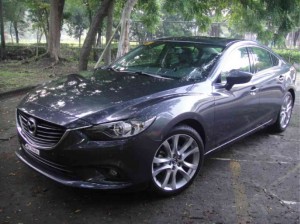
THE NEW Mazda6’s low-slung profile combines Kodo, the soul of dynamic motion, with Skyactiv technology.
Last April, Mazda Motor Co., Japan’s fifth biggest automaker by number of units produced and the most export-reliant, announced that it will post a net profit for the first time in five years. While the weakening of the yen by 21 percent against the dollar since mid-November contributed to the $261.1 million net profit, Mazda executives said new technologies dubbed SkyActiv also played a key role in the company’s rebound.
SkyActiv, which Mazda began rolling out in 2011, is a set of technologies centering around revamps of car designs, engines, transmission and chassis that together produce a vehicle whose fuel economy rivals that of a hybrid gasoline-electric car. The first Mazda vehicle to incorporate the entire set of SkyActiv technologies was the Mazda CX-5 crossover which was launched in Manila in 2012.
Now comes the second SkyActiv car, the entirely redesigned, third generation Mazda6, the company’s flagship sedan. Categorized as a midsize family-cum-executive sedan competing with the Toyota Camry and Honda Accord from the time it was introduced in 2002, the Mazda6 has been transformed into a sports sedan—not only because of its all-new, athletic and graceful “Kodo soul of motion” exterior design that stands out in a segment dominated by dowdy designs, but also because of its upgraded handling and performance dynamics.
On the other hand, the 2014 Mazda6 eschews the concept of sports sedans as fuel-thirsty cars precisely because of its total application of SkyActiv technologies. Despite its hunky, broad-shouldered sculpture and longer wheelbase, the new 6’s SkyActiv body weighs about 300 pounds lighter than its predecessor, which translates into more frugal fuel consumption. Like the CX-5, the 6’s use of more high-strength steel increased torsional rigidity, resulting in a strong SkyActiv chassis and body while at the same time reducing mass and weight. The 6’s streamlined profile and lighter curb weight have improved aerodynamic efficiency to a drag coefficient of 0.26.
i-ELOOP. Aside from its class-leading lightness of being, the new 6 has what the competition doesn’t have to further enhance fuel efficiency: i-Eloop, which recovers energy from braking to help power the car’s electric systems. Other brands also store and reuse energy, but unlike those, the 6 does not feed energy back into the battery—instead, the 6 feeds it to an electric double-layer capacitator that can be charged in seven seconds. When fully charged, the capacitator can run the car’s ancillaries for a minute.
Working hand in glove with Mazda’s i-Stop system that automatically cuts the engine when the car comes to a full stop after braking, the capacitator powers the audio system, the air conditioner and other equipment temporarily. Together, the two systems, i-Eloop and i-Stop, improve fuel economy by about 10 percent to an amazing real-world average of 15 kilometers per liter, according to Mazda.
When I was driving the Mazda6 for a week, I noticed that the 2.5-liter DOHC direct-injected aluminum 4-cylinder SkyActiv-G engine was a bit slow accelerating off the line. This perceived initial deficiency is due to the long-stroke design with variable valve timing of the powertrain and the long gears of the SkyActive 6-speed automatic transmission which Mazda engineers tuned to promote fuel economy over performance.
UNLEASHED. However, once I reached the traffic-free Skyway and stepped on the gas to unleash the 6’s available power, it effortlessly, smoothly and quietly overtook other vehicles. Once underway, the SkyActiv-G engine gets more powerful as the RPMs increase and moves the 6 above 5000 revolutions per minute. Top speed is rated at 223 kilometers per hour. The engine’s exceptionally high injection pressure and very high 14:1 compression ratio make it possible to run on regular unleaded gasoline, although Mazda engineers probably detuned the 6’s engine to cope with the quality of fuel sold in the Philippines.
What is endearing about the 6 is that it delivers an ultraquiet, refined, comfortable ride during high-speed cruising as well as during sedate driving. The SkyActiv-G engine does not become buzzy when pushed to its upper limits and the only noise you will hear is road and wind noise. And when it comes to handling, the Mazda6 beats the competition without question. Steering is precise, smooth and confident enough to merit further exploration on a track with a set of double-apex turns, ess bends and slalom maneuvers, although some understeer is inevitable when cornering because the 6 is a front-drive car. Despite its light weight, the 6’s solid stability and nimbleness allow you to speed up in situations where others are slowing down.
Mazda retuned the suspension system for a nice balance between riding comfort and sporty grip even with the aggressive 225/45R19 tires that come as standard equipment with the 6. The precise, tactile steering system, enhanced by electric power-assisted rack and pinion steering, makes the 6 the enthusiast’s delight. Not only is the 6 one of the most engaging cars to drive in the midsize sedan segment, it offers a level of ride quality equivalent to if not better than the leading brands.
Bottom line, with all its SkyActiv attributes plus its roomy and fully kitted cabin, stunning good looks, fantastic fuel economy, precise steering, smooth ride, quiet operation, array of active and passive safety features including six airbags, the Mazda6 has been transformed from an also-ran in the midsize family/executive sedan segment into a game-changing sports sedan. At P1.705 million, the transformed 2014 Mazda6 is, peso for peso, value for money.